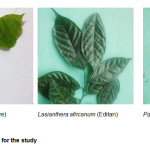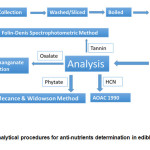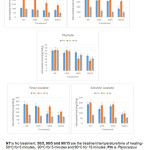Introduction
Vegetables form an integral part of meals of people in Akwa Ibom State of Nigeria. Invariably, vegetables present a rich source of vitamins, minerals, fibre and protein. Green leafy vegetables despite their nutritional value are to be consumed with caution because of the presence in them of toxic anti-nutrients.1-5 Anti-nutrients are natural compounds that interfere with the absorption of nutrients, hence are known to reduce nutrients availability to animals and humans.6-9 The higher the concentrations, the greater the risk posed on consumption. Adeboye and Babajide1 report that the presence of anti-nutrient components in green leafy vegetables impair efficient utilization of calcium, zinc, iron and copper by the formation of insoluble complexes with the mineral elements.
Common anti-nutrients found in vegetables include: tannin, hydrocyanic acid (HCN) saponins, oxalates, phytates and polyphenols.5,10-13 These anti-nutrients are usually present in trace amount, and are found at different levels in almost all foods. The levels in food crops however, get reduced by in-home preparations and storage techniques.13-15 According to Anderson,16 anti-nutrients easily can be detoxified by various processing methods such as soaking, boiling and frying. Processing partly removes anti-nutrients and lowers food toxicity17; however, consumption of very large quantities of such food may still result in a health risk.
The main objective of this study is to determine the effect of temperature (heating in water) on the levels of some anti-nutrients (HCN, tannins, phytate and oxalate) in three local edible vegetables, Pterocarpus mildbraedii, Lasianthera africanum and Piper guineense purchased in Uyo, Nigeria.
Materials and Methods
Sample collection and treatment
The leaves of Pterocarpus mildbraedii, Lasianthera africanum and Piper guineense (Figure 1) were purchased from Akpan Andem market in Uyo, Akwa Ibom state, Nigeria. Each vegetable sample was destalked, washed, shredded and divided into four lots. The first lot was sun-dried, ground into fine powder with a manual blending machine and stored in a well-labelled air-tight container. The other three lots were heated on a temperature-regulated hot plate at temperatures of 50oC for 5 minutes, and 90oC for 5 and 15 minutes. After heating, the vegetables were sun-dried, ground into fine powder and stored in well- labelled air-tight containers.
 |
Figure 1 : Edible vegetables used for the study Click here to View figure |
Determination of anti-nutrients
Hydrocyanic acid (HCN) content was determined using the alkaline picrate method.18 Fifty milliliters (50 ml) of distilled water was added to 5 gm of the ground sample in a conical flask and allowed to stay overnight. Four milliliters (4 ml) of alkaline picrate was then added to 1ml of the filtrate extracted in a corked test tube, and incubated in a water bath for 5 minutes. The absorbance was read with a spectrophotometer at 400 nm. Absorbance of the blank solution containing 1ml of distilled water and 4ml alkaline picrate was also read. The hydrocyanic acid content was then extrapolated from the standard curve.
Tannin content was determined by the Folin-Denis spectrophotometric method described by Pearson.19 One gramme of the sample was added to 10 ml of distilled water. The filtrate was poured into a 50 ml volumetric flask. Two point five millilitre (2.5 ml) tannic acid was added to another 50 ml volumetric flask to prepare the standard solution. One milliliter (1ml) Folin-Denis reagent was then added to each flask followed by 2.5 ml of saturated Na2CO3 solution and incubated for 90 minutes; the absorbance was read at 250 nm with a spectrophotometer.
Phytic acid content was determined as described by Mecance and Widowsen,20 using the permanganate titration method. The procedures for the anti-nutrients determination are summarised in Figure 2.
 |
Figure 2: Analytical procedures for anti-nutrients determination in edible vegatables Click here to View figure |
Analar-grade reagents were used in the preparation of all solutions. Quality control was ensured by the use of duplicates and procedural blanks. Microsoft Excel was used for all statistical analyses.
Results and Discussion
The effects of temperature on the anti-nutrients content of Pterocarpus mildbraedii, Lasianthera africanum and Piper guineense are presented in Figure 3 and Table 1.
 |
Figure 3: Changes in anti-nutrients levels at different temperatures and timesClick here to View figure |
Table 1: Percentage reduction of anti-nutrients contents in edible vegetables
|
Anti-nutrients |
Vegetables |
Percentage reduction (%) |
||
| 50oC for 5 minutes | 90oC for 5 minutes | 90oC for 15 minutes | ||
| HCN | Pterocarpus mildbraedii | 17.6 | 26.9 | 23.6 |
| Lasianthera africanum | 13.9 | 33.9 | 43.5 | |
| Piper guineense | 14.1 | 43.1 | 50.0 | |
| Tannin | Pterocarpus mildbraedii | 9.1 | 12.8 | 53.4 |
| Lasianthera africanum | 6.1 | 6.9 | 25.0 | |
| Piper guineense | 35.1 | 50.3 | 51.9 | |
| Phytate | Pterocarpus mildbraedii | 11.0 | 8.8 | 25.5 |
| Lasianthera africanum | 1.4 | 41.9 | 51.8 | |
| Piper guineense | 5.8 | 22.9 | 40.2 | |
| Total oxalate | Pterocarpus mildbraedii | 9.5 | 49.7 | 56.2 |
| Lasianthera africanum | 13.8 | 10.3 | 37.9 | |
| Piper guineense | 15.4 | 23.0 | 23.0 | |
| Soluble oxalate | Pterocarpus mildbraedii | 23.8 | 9.5 | 52.4 |
| Lasianthera africanum | 13.0 | 8.6 | 52.2 | |
| Piper guineense | 22.2 | 33.3 | 33.3 | |
HCN mean levels of fresh Pterocarpus mildbraedii, Lasianthera af ricanum and Piper guineense leaves were 106.6, 248.8 and 94.8 mg/100g respectively (Figure 3). Generally, the HCN content decreased with heating; at 50oC for 5 minutes, percentage reductions were 17.6%, 13.9% and 14.1%, and 90oC for 15 minutes, 23.6%, 43.5% and 50% for Pterocarpus mildbraedii, Lasianthera africanum and Piper guineense respectively. More reduction occurred at 90oC for 15 minutes for the vegetable except for Pterocarpus mildbraedii with highest reduction at 90oC for 5 minutes. The percentage HCN reduction in this study is much on the increase at high temperature (90oC); the trend is similar to the findings of Ugwu and Oranye10 that reported significant reduction in HCN level of Treculia africana after boiling at 100oC for 120 minutes. The HCN levels in the three vegetables prior to heating are higher than the lethal dose for man.21 Cyanogens can be hydrolysed by enzymes to release a volatile HCN gas. High levels of HCN has been implicated in cerebral damage and lethargy in animal and human.22 The lethal dose for an adult depends on body weight and nutritional status, and is between 30 and 210 mg of hydrogen cyanide; while the lethal dose of HCN for cattle and sheep is 2.0-4.0 mg/kg body weight.17 On heat treatment, HCN in the vegetables fell to within the Food Standards of Australia New Zealand (FSANZ).17
Tannins are water soluble phenolics compounds with ability to bind protein from aqueous solutions. They are toxic and interfere with digestion and absorption of proteins and, also the utilization of vitamins and minerals.23-25 The mean levels of tannin for Pterocarpus mildbraedii, Lasianthera africanum and Piper guineense were 715.5, 822.6 and 383.3 mg/100g respectively. The vegetables, except Piper guineensis, have levels higher than other commomly consumed vegetables, like Talinum triangulare (180 mg/100g) and Telfairia occidentalis (420 mg/100g).26 Consumption of fresh herbal preparations as is common among local communities in Nigeria either as remedies for health conditions or to promote vitality/improved health, may portend health risk especially to children, in terms of growth challenges and general well-being where the preparations are to contain extracts of Pterocarpus mildbraedii and/or Lasianthera af ricanum. The high tannin content however, reduced on heating (Table 1). At 50oC for 5 minutes, percentage reductions were 9.1%, 6.1% and 35.1%, and 90oC for 15 minutes, 53.4%, 25.0% and 51.9% for Pterocarpus mildbraedii, Lasianthera africanum and Piper guineense respectively. Highest reduction of the anti-nutrient occurred at 90oC for 15 minutes for all vegetables. This is in line with results obtained by Lola (2009) who reported tannin content reduction of non-conventional vegetables to the minimum when boiled.
Phytate mean levels in untreated Pterocarpus mildbraedii, Lasianthera africanum and Piper guineense of 35.3, 36.3 and 36.1 mg/100g respectively, were higher than the recommended level of 25 mg/100g in food27; with Lasianthera africanum recording the highest. The levels though are lower than in Telfairia occidentalis (50 mg/100g) and Basella alba (80 mg/100g).26 Phytate is associated with nutritional disease such as ricket in children and osteomalacia in adults. Phytic acid acts as strong chelator forming protein and mineral-phytic acid complexes thereby reducing protein and mineral bioavailability.22 An intake of 4-9 mg/100g of phytate is said to decrease Fe absorption by 4-5 folds in humans.28 The phytate in the vegetables reduced with increase in temperature and heating time. The percentage reductions in Pterocarpus mildbraedii, Lasianthera africanum and Piper guineense at 50oC for 5 minutes were 11.0%, 1.4% and 5.8%, and 25.5%, 51.8% and 40.2% respectively, at 90oC for 15 minutes. However, the level at 90oC for 15 minutes (26.3 mg/100g for Pterocarpus mildbraedii) remained slightly above the recommended, indicating possible need for a little more heating time.
Oxalates chelate bivalent minerals such as Ca and Fe. This has serious implication for health, particularly in children, pregnant and lactating mothers that require more Ca and Fe.7 High intake of oxalate predisposes to renal disorder through formation of kidney stones24 and rarely, disorder of central nervous system.5 The values obtained in the present study are lower than the lethal dose of 200-500 mg/100g oxalate reported by Bushway et al.,29 Acamovic et al.,1-5 reported 20 g/kg to be lethal to chicken. It has also been reported that the lethal level of oxalate in man is 3-5 g,31 and that daily intake of 450 mg of oxalic acid interferes with various metabolic processes.8 The mean content of total and soluble oxalate in untreated vegetables ranged from 114.4 (Piper guineense) – 262.4 (Pterocarpus mildbraedii) mg/100g and 79.2 (Piper guineense) – 202.4 (Lasianthera africanum) mg/100g respectively (Figure 3). The oxalate content is higher than in Solanum macrocarpon reported in Adeboye and Babajide1 but lower than for Ipomoea batatas vegetable in Antia et al.,32 The levels of total and soluble oxalate reduced after heating in all the vegetables (Table 1). The highest percentage reduction for total and soluble oxalate was observed in Pterocarpus mildbraedii (56.2% and 52.4% respectively) followed by Lasianthera africanum (37.9% and 52.2% respectively) at 90oC for 15 minutes. Udousoro and Udiong33 reported 88% and 64.7% percentage reduction in total and soluble oxalate content of Lasianthera africanum collected from Oku Abak, in Akwa Ibom State of Nigeria when heated at 90oC for 15minutes; values that are much higher than in this study.
On the other hand, the levels of HCN (2.15 mg/100g), tannin (5.43 mg/100g), phytate (29.5 mg/100g), total oxalate (154 mg/100g) and soluble oxalate (74.8 mg/100g) in Lasianthera africanum obtained from Abak33 are much lower than levels of HCN (248.8 mg/100g), tannins (822.6 mg/100g), Phytate (36.3 mg/100g), total oxalate (255.2 mg/100g), and soluble oxalate (202.4 mg/100g) for Lasianthera africanum in the present study. The wide disparity in anti-nutrients in the edible vegetables could be explained by the fact that anti-nutrients are genetically controlled and depend on factors such as soil type, location, plant’s age and maturity, type of plant as well as the position of leaves.9,24,34
Conclusion
The edible vegetables in this study contained anti-nutrients in varying concentrations. Tannins recorded highest levels in all the vegetables followed by total oxalate, while phytate was lowest. On comparative scale, Piper guineense contained the lowest values of all anti-nutrients; Lasianthera africanum had highest anti-nutrients values with the exception of total oxalate, while total oxalate was highest in Pterocarpus mildbraedii. Heating generally reduced the anti-nutrients (HCN, tannin, phytate and oxalate) levels as evident in percentage reduction as temperature and heating time increased. From the results, it can be concluded that controlled heating is effective processing method for reduction of anti-nutrients in the selected vegetables. And as the anti-nutrient levels are markedly reduced at temperature less than boiling, processing the vegetables for food may not necessarily require boiling, rather with heating time of not less than 15 minutes for processing the vegetables; this in effect will ensure optimum availability of their nutrients.
Acknowlegements
The authors are grateful to Staff of Biochemistry Lab. College of Basic Medicine, University of Uyo, Uyo, Akwa Ibom State, Nigeria for making the Lab available for anti-nutrient determination.
References
- Adeboye A. S. and Babajide J. M. Nigeria Food J., 25(2), 77 (2007).
- Akubugwo I. E., Obasi N. A., Chinyere G. C. and Ugbogu A. E. Afr. J. Biotechnol., 6(24), 2833 (2007).Chinma C. E. and Igyor M. A. Nigerian Food J., 25(1), 111 (2007).
- Isong E. U. and Essien I. B. Plant Foods Hum. Nutr., 49(2), 133 (1996).
CrossRef - Noonan S. C. and Savage G. P. Asia Pacific J. Clin. Nutr., 8(1), 64 (1999).
CrossRef - Gupta Y. P. Plant Foods Hum. Nutr., 37, 201-228 (1987).
CrossRef - Guil U. R., Rodrígez-García I. and Torija E. Plant Food Hum. Nutr., 51, 99 (1997).
CrossRef - Akwaowo E. U., Ndon B. A. and Etuk E. U. Food Chem. 70: 235 (2000).
CrossRef - Ingebrigtsen K. Main plant poisonings in livestock in the Nordic countries. Proceedings from a symposium held at the Norwegian Academy of Science and Letters, Oslo, 13-14 Nov., 2008, pages 30-43, (2010).
- Ugwu F. M. and Oranye N. A. Afr. J. Biotechnol., 5(22), 2329 (2006).
- Rehman Z. and Shah W. H. Food Chem., 91(2), 327 (2005).
CrossRef - Akande K. E. and Fabiyi E. F. International J. Poultry Sci., 9(10), 996 (2010).
CrossRef - Lola A. Pak. J. Nutr., 8(9), 1430 (2009).
CrossRef - Adetuyi F O., Akinadewo L. T., Omosuli S. V. and Ajala L. Afr. J. Biotechnol., 7(16), 2920 (2008).
- Adetuyi F. O., Osagie A. U. and Adekunle A. T. Pak. J. Nutr., 7(5), 652 (2008).
CrossRef - Anderson E. N., Everyone Eats: Understanding Food and Culture, New York University Press, New York, 47 (2005).
- FSANZ Cyanogenic glycosides in cassava and bamboo shoots: A human health risk assessment, Technical report series no. 28, Food Standards Australia New Zealand, 24pp (2005). www.foodstandards.gov.au retrieved October 02, 2014
- A.O.A.C. Association of Official Analytical Chemists, Official Methods of Analysis, 15th Edition, Washington DC, USA (1990).
- Pearson D. A. and Cox H. E. The Chemical Analysis of Foods, Seventh Edition, Churchill Livingstone, Edinburgh; New York, 575pp (1976).
- McCance R. A. and Widdowson E. M. Biochemical J., 29(12), 2694 (1935).
CrossRef - Oke O. L. J. Amer. Diet Assoc., 53(2), 130 (1968).
- Agbaire P. O. Afr. J. Food Technol. 3(4), 99 (2012).
- Aleto V. A. Vet. Hum. Toxicol., 35(1), 57 (1993).
- Getachew A. G., Asfaw Z., Singh V., Woldu Z, Baidu-Forson J. J. and Bhattacharya S. Afr. J. Food Agric. Nutr. Development, 13(2), 7485 (2013).
- USEPA Inert Reassessment – Tannin (CAS Reg. NO. 1401-55-4). Office of prevention, pesticide and toxic substance, United States Environmental Protection Agency, Washington, D.C. 20460, 16pp (2006). http://www.epa.gov/opprd001/inerts/tannin.pdf Retrieved October 02, 2014
- Adegunwa M. O., Alamu E. O., Bakare, H. A. and Onyeniyi, C. O. Amer. J. Food Nutr., 1(4), 171 (2011).
CrossRef - Nagel R. Living with phytic acid. The Weston A. Price Foundation (2010). http://www.westonaprice.org/food-features/living-with-phytic-acid Retrieved on Sunday, Feb. 24, 2013.
- Hurrel R. F., Jullert M. B., Reddy S. R., Lynch S. D. and Cook J. D. Amer. J. Clin. Nutr., 56, 573 (1992).
CrossRef - Bushway R. J. Burean J. I. and Gann D. F. J. Food Sci., 48(2), 84 (1998).
- Acamovic T., Steward C. S. and Pennycott T. W. (eds) Poisons Plants and Related Toxins, Oxford University Press, 608pp (2004).
CrossRef - Munro A. and Bassir O. J. J. Biology Applied Chem., 12, 14 (1973).
- Antia B. S., Akpan E. J., Okon P. A. and Umoren I. U. Pak. J. Nutr., 5(2), 166 (2006).
CrossRef - Udousoro I. I. and Udiong D. International J. Food and Safety, 3(2), 81 (2013).
- Franceschi V. R. and Nakata P. A. Ann. Rev. Plant Biol., 56: 41 (2005).
CrossRef

This work is licensed under a Creative Commons Attribution 4.0 International License.





